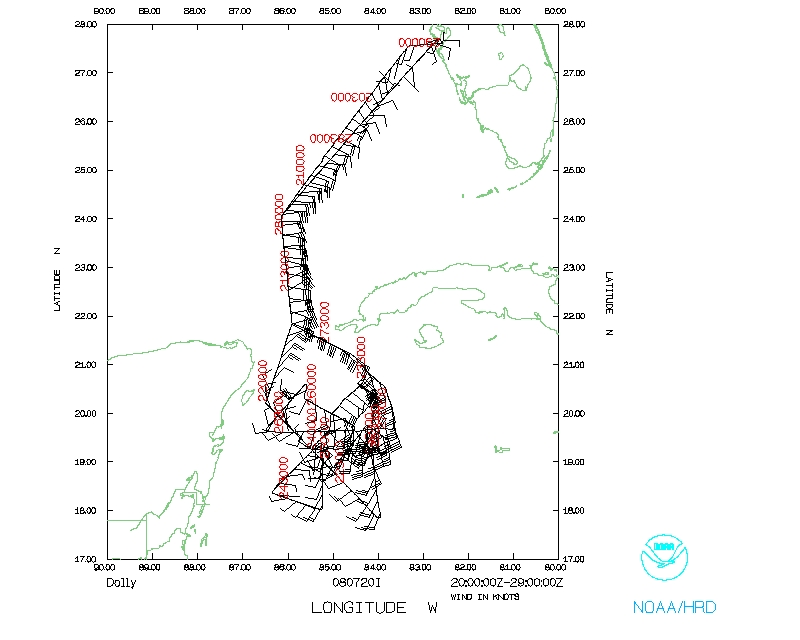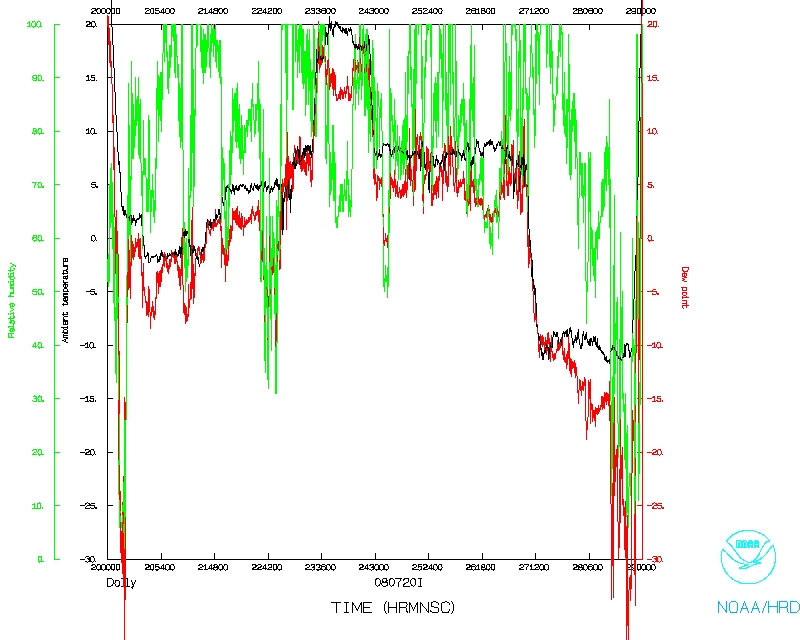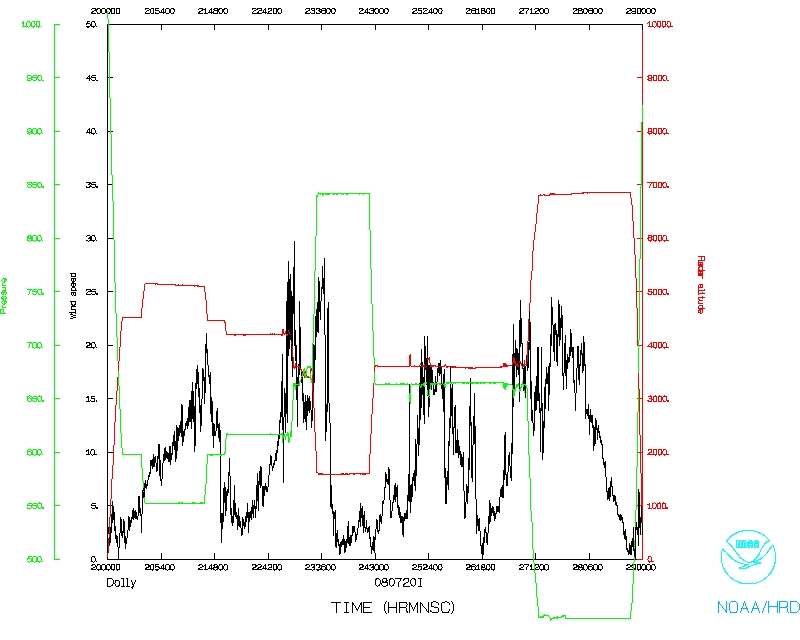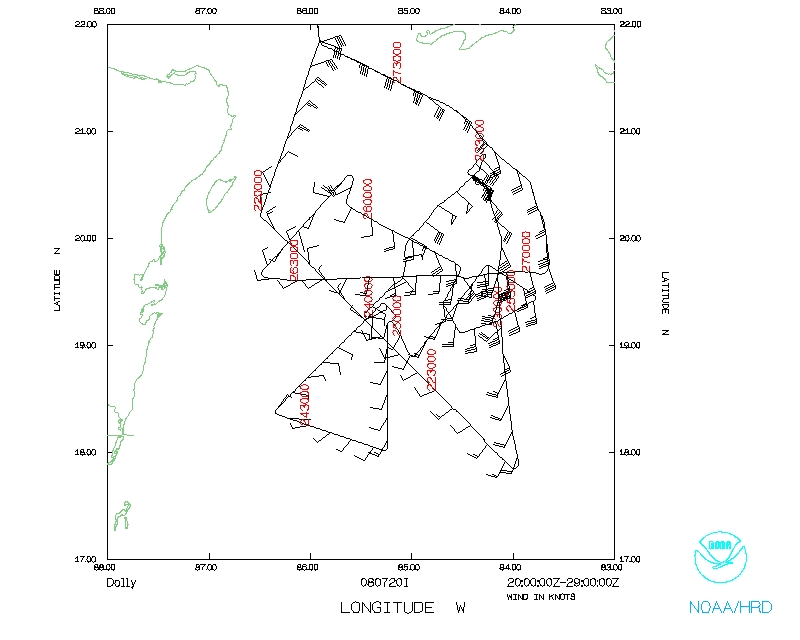Mission Summary
Tropical Storm Dolly
3-D Doppler Winds Operational Mission
20080720I1 Aircraft: N43RF
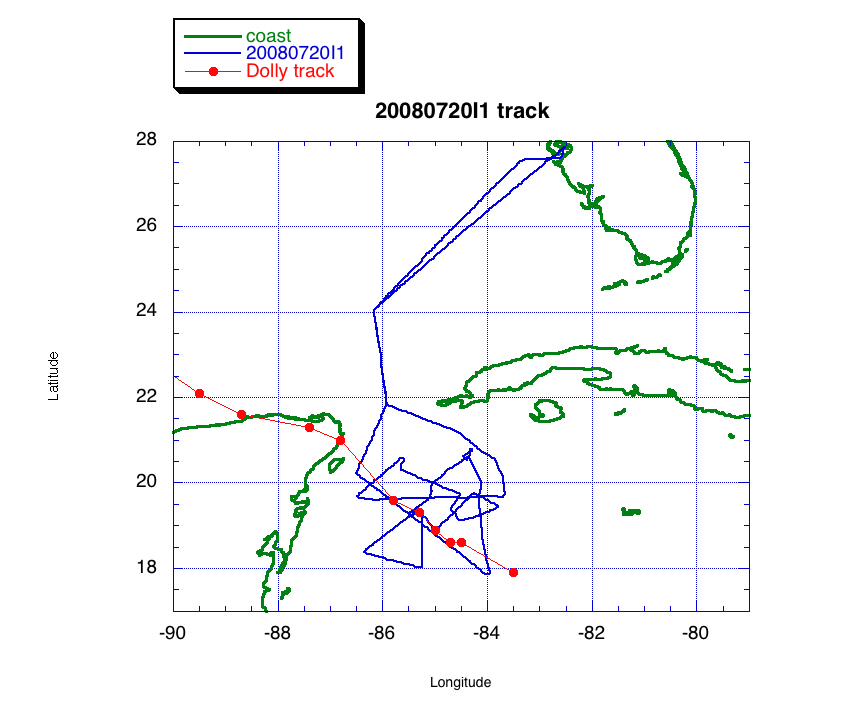
Scientific Crew:
| Lead Project Scientist | Robert Rogers
|
Radar Scientist
Workstation Scientist | Paul Leighton
|
| Dropsonde Scientist | Kathryn Sellwood
|
Aircraft Crew:
| Pilots | Mark Nelson
Carl Newman |
| Flight Engineers | Dewie Floyd |
| Navigator | Joe Bishop |
| Flight Director | Jack Parrish |
| Data Technicians | Terry Lynch, Jeff Smith |
| Elec. Technician | Damon SanSouci |
Mission Plan :
This was a
combination EMC 3-D Doppler winds/NHC fix mission with an HRD convective burst
module, if possible, into Tropical Storm Dolly, which had just been named a
tropical storm prior to the mission. The pattern called for a rotated figure-4
pattern, with an IP on the northwest side. The leg lengths were to be 105 nm,
flown at 14,000 ft altitude, except for the leg during which the fix would
occur (at 00 UTC July 21), during which the altitude would be 5000 ft. If the
opportunity arose, a convective burst module would be flown, which would
consist of flying a box pattern around the area of the burst, dropping sondes
at each corner point, and one sonde in the center of the burst. Other than the
burst pattern, the plan called for dropping sondes at each turn point, the mid
points of the legs, and on the first and last center pass
(Fig. 1). Also, if
possible, the aircraft would do 45-degree banked circles three times in clear
air and high winds, and drop one sonde in weak surface winds and heavy rain.
If arc clouds were present, sondes would be dropped across them too.
Mission Summary :
| Take off
| Landing
| MacDill AFB, FL | 19:59 UTC
| MacDill AFB, FL | 05:04 UTC
| |
Takeoff from Tampa was at 1959 UTC. Dolly was a disorganized system located
in the northwest Caribbean at this time
(Fig. 2).
There were areas of cold cloud tops in the infrared imagery, indicative of
deep convection. The presence of deep convection was confirmed by microwave
imagery (Fig. 3), which shows
isolated areas where the 85 GHz PCT is less than 150 K on the east and south
side of the storm center. Much of this convection was displaced to the north
and east of the circulation center, possibly in response to southwesterly shear
from an upper-level low located west of the storm
(Fig. 4). Despite the
presence of deep convection, the circulation associated with Dolly was
ill-defined. QuikScat imagery during this time
(Fig. 5) shows that there was
no closed circulation at the surface, at least in an Earth-relative framework.
The actual flight track followed
the proposed flight track reasonably well
(Fig. 6a). The looping pattern
between points 5 and 6 was associated with a convective burst module flown
around the area of deep convection seen at 17°N 84°W in
Fig.3a. During the
first downwind leg (between points 2 and 3), the aircraft flew
the banked SFMR test. Throughout the flight the coldest cloud shield (and
deepest convection) was located north and east of the center of circulation at
flight-level (Fig. 6b).
Flight-level winds, which for most of the pattern were at 12,000 ft. altitude
(except for leg 3-4 at 5000 ft.) showed a disorganized flow pattern, with an
indication of multiple circulation centers primarily southwest of the cold
cloud shield. It was evident from lower fuselage imagery that the
bulk of the convection was on the east side of the primary circulation center.
As a result, on the inbound leg flown after reaching point 5 the convective
burst module was flown around a line of vigorous convection located about 50 nm
east of the center
(Fig. 7). The aircraft flew
a box around the convection, generally within about 10-20 km of the line.
GPS sondes were dropped at each corner point of the box. Upon completion of
the box the aircraft returned to a point north of the center to resume the
primary pattern. Along the way, however, the aircraft flew alongside a line
of more stratiform precipitation, again flying within about 10-20 km of the feature.
The mission accomplished the objectives. We collected the fix for NHC,
obtained radar coverage in all quadrants for EMC, and flew the convective
burst and banked SFMR module for HRD. We could not fly an arc cloud module
because there were not any obvious such features at the time of takeoff and
none were obvious in the lower fuselage imagery. The storm was very
asymmetric, with near-zero surface and flight-level winds on the west, south,
and southwest sides of the storm and strong winds on the east and northeast
sides.
Despite the presence of persistent deep convection, the storm could never
develop a closed surface circulation. It appeared that southwesterly shear
from the upper-level low to the west of the storm may have been the reason for
this lack of significant intensification, as well as the proximity to the
Yucatan peninsula. We did obtain good measurements of some convective features
which should allow for the diagnosis of various statistics in the convective
and stratiform regions to the northeast.
Problems :
There were no
problems with expendables. The only issue was an inability to set PRF on the
tail radar above 1600 Hz. Otherwise the flight went well.
Robert Rogers
7/30/08
Mission Data
1 second data file |
NetCDF data file
Page last updated July 30, 2008
Return to Mission page.

